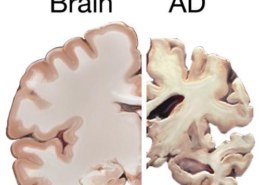Kio Estas La Diferenco Inter Alzheimers kaj Demenco
Alzheimer-malsano kaj demenco estas kutime viditaj en maljunuloj. Ambaŭ malsanoj difektas kognan funkcion. Alzheimer-malsano estas la plej ofta kaŭzo de demenco. Ambaŭ malsanoj influas ne nur memoron, sed ankaŭ aliajn kognajn funkciojn. Ĉi tie ni diskutos ĉion ĉi detale, reliefigante iliajn tipojn, klinikaj trajtoj, signoj kaj simptomoj, kaŭzoj, esplorado kaj diagnozo, prognozo, traktado kaj prizorgo, kaj la diferenco inter Alzheimer-malsano kaj demenco.
Alzheimer
Alzheimer-malsano ne estas kuracebla, kaj ĝi progresas laŭlonge de la tempo, difektante kognan funkcion. La apero kaj progresado de Alzheimer-malsano estas unikaj por ĉiu paciento. La vera kaŭzo de Alzheimer ankoraŭ estas nekonata. Iuj sugestas, ke tio estas pro la formado de plakoj en la cerbo kaj neŭralaj implikaĵoj. La frua stadio de Alzheimer-malsano manifestiĝas per perdo de memoro pri lastatempaj eventoj. Kun la tempo, estas konfuzo, malstabila humoro, kolerego, agresema konduto, problemoj kun parolado kaj kompreno, kaj malbona longtempa memoro. Sociaj interagoj plimalboniĝas dum la malsano progresas. Malrapide, la funkcioj de la korpo malboniĝas, kondukante al morto. Estas tre malfacile antaŭdiri vivdaŭron kaj progresadon de la malsano pro individuaj diferencoj.
En multaj homoj, Alzheimer-malsano iras nerimarkita. Post diagnozo, homoj kutime vivas proksimume sep jarojn. Nur malgranda procento de homoj vivas pli longe ol dek kvar jarojn post diagnozo. Testoj, kiuj taksas pensajn kaj kondutismajn kapablojn, konfirmas la diagnozon de Alzheimer-malsano. Cerbaj skanadoj provizas la ŝlosilon por ekskludi aliajn diagnozojn, kiel ekzemple bato, cerba hemoragio, kaj spaca damaĝo.

varikaj vejnoj 01: Alzheimers Cerbo
La disponeblaj kuracaj elektoj ne estas kuracaj. Ili nur mildigas la simptomojn. Ĉi tiuj drogoj ne influas la progresadon de la malsano. Estas diversaj alternativaj traktadoj haveblaj, sed ne ekzistas datumoj pri sekureco aŭ efikeco. La prizorganto estas esenca en la kuracado de Alzheimer-malsano.
Demenco
Demenco karakterizas per malobservo de ĉiuj kognaj funkcioj, familio Jugladacoj, pro normala maljuniĝo. Demenco estas aro de simptomoj kiuj povas esti progresemaj (plej ofte) aŭ statika, rezultanta el degenero de la cerba kortekso, kiu regas la” pli altan ” funkcioj de la cerbo. Ĉi tio rezultigas difektitan memoron, pensante, lernkapablo, lingvo, juĝo, Orientiĝo, kaj kompreno. Ili estas akompanitaj de problemoj kun kontrolado de emocioj kaj konduto. Demenco estas plej ofta inter maljunuloj, kie taksita 5% de la tuta loĝantaro super 65 estas implikita. Laŭ aktuala statistiko, demenco influas 1% de la loĝantaro sub la aĝo de 65, 5-8% de homoj aĝaj 65 al 74, 20% de homoj aĝaj 75 al 84, kaj 30-50% de homoj aĝaj 85 kaj pli malnovaj. Demenco kovras larĝan gamon de klinikaj signoj.
Kvankam ne ekzistas malsamaj specoj de demenco, ĝi povas esti larĝe dividita en tri laŭ la naturhistorio de la malsano. Fiksa kogna difekto estas speco de demenco, kiu ne progresas en severeco. Ĉi tio estas la rezulto de iu organika cerba malsano aŭ vundo. Vaskula demenco estas demenco kun fiksaj malordoj. (Ekzemple: bato, malfacileco por spirado, malpliigita oksigenado de cerba cirkulado). Malrapide progresema demenco estas speco de demenco, kiu komenciĝas kiel perioda perturbo de la pli altaj funkcioj de la cerbo kaj malrapide plimalboniĝas al la stadio kie la agado de la ĉiutaga vivo estas interrompita.. Ĉi tiu tipo de demenco kutime okazas pro malsanoj, en kiuj la nervoj malrapide degeneras (neŭrodegenerativa). Frontotempa demenco estas malrapide progresema demenco kaŭzita de malrapida degenero de la strukturoj de la fruntloboj.. Semantika demenco estas malrapide progresema demenco kiu estas karakterizita per la perdo de la signifo de vorto kaj la signifo de parolado.. Difuza demenco de la Levi-korpo similas al Alzheimer-malsano, krom la ĉeesto de Levi-korpoj en la cerbo. (Ekzemple: Alzheimer-malsano, multobla sklerozo). Rapide progresema demenco estas speco de demenco, kiu manifestiĝas ne post jaroj, sed en nur kelkaj monatoj. (Ekzemple: Creutzfeldt-Jakob-malsano, priona malsano).
Traktado de ajna primara malordo, traktado de supermetita deliro, traktante eĉ etajn medicinajn problemojn, inkluzive de familia subteno, la provizo de praktika helpo hejme, helpo por prizorgantoj, drogtraktado kaj organizo-pacienta prizorgo en kazo de rifuzo hejma prizorgado estas la ĉefaj principoj de la prizorgado de Imbeciles. Medikamento estas uzata nur kiam la eblaj kromefikoj estas superpezitaj de la avantaĝoj. Por severaj ŝanĝoj en konduto, kiel ekscitiĝo, emocia malstabileco, epizoda uzo de sedativoj (Promazino, Tioridazino) estas rekomendinda. Kontraŭpsikozaj drogoj povas esti preskribitaj por iluzioj kaj halucinoj. Se depresivaj trajtoj estas profundaj, antidepresiva terapio povas esti komencita. Centre agantaj kolinesterazo-inhibitoroj estas utilaj por proksimume duono de pacientoj suferantaj de demenco pro Alzheimer-malsano.. Ili ŝajnas prokrasti la progresadon de kogna difekto kaj en iuj kazoj eĉ povas plibonigi simptomojn dum kelka tempo.
Kio estas la diferenco inter Alzheimer kaj Demenco?
* La kuracebleco de demenco dependas de la kaŭzo, dum Alzheimer estas nekuracebla kaj progresema.
* Alzheimer-malsano kutime komenciĝas kiel momenta memorperdo, dum demenco ĉeestas en diversaj manieroj.
* La ĉefa simptomo de Alzheimer-malsano estas memorperdo, dum demenco manifestiĝas malsame depende de la speco de demenco.
* Alzheimer-malsano montras perdon de funkcio en la temporallobo dum PET-skanado, dum demenco montras tutmondan perdon de funkcio.
KREDITO
www.differencebetween.com/difference-between-alzheimers-and-dementia
Bildo Ĝentileco:
1.’Alzheimers cerbo’ By Naciaj Institutoj de Sano (Publika Domeno) via Komunejo Vikimedio



Lasu respondon
Vi devas Ensaluti aŭ registri aldoni novan respondon.